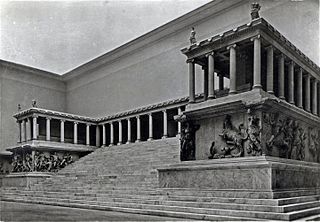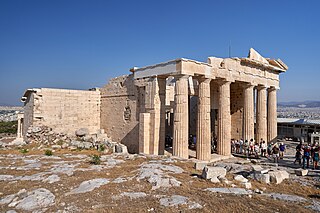
The Acropolis of Athens is an ancient citadel located on a rocky outcrop above the city of Athens, Greece, and contains the remains of several ancient buildings of great architectural and historical significance, the most famous being the Parthenon. The word Acropolis is from the Greek words ἄκρον and πόλις. The term acropolis is generic and there are many other acropoleis in Greece. During ancient times the Acropolis of Athens was also more properly known as Cecropia, after the legendary serpent-man Cecrops, the supposed first Athenian king.

Pergamon or Pergamum, also referred to by its modern Greek form Pergamos (Πέργαμος), was a rich and powerful ancient Greek city in Mysia. It is located 26 kilometres (16 mi) from the modern coastline of the Aegean Sea on a promontory on the north side of the river Caicus and northwest of the modern city of Bergama, Turkey.

Miletus was an ancient Greek city on the western coast of Anatolia, near the mouth of the Maeander River in ancient Ionia. Its ruins are located near the modern village of Balat in Aydın Province, Turkey. Before the Persian rule that started in the 6th century BC, Miletus was considered among the greatest and wealthiest of Greek cities.

The Pergamon Museum is a listed building on the Museum Island in the historic centre of Berlin, Germany. It was built from 1910 to 1930 by order of Emperor Wilhelm II and according to plans by Alfred Messel and Ludwig Hoffmann in Stripped Classicism style. As part of the Museum Island complex, the Pergamon Museum was added to the UNESCO World Heritage List in 1999 because of its architecture and testimony to the evolution of museums as architectural and social phenomena.

Magnesia or Magnesia on the Maeander was an ancient Greek city in Ionia, considerable in size, at an important location commercially and strategically in the triangle of Priene, Ephesus and Tralles. The city was named Magnesia, after the Magnetes from Thessaly who settled the area along with some Cretans. It was later called "on the Meander" to distinguish it from the nearby Lydian city Magnesia ad Sipylum. It was earlier the site of Leucophrys mentioned by several ancient writers.

The Pergamon Altar was a monumental construction built during the reign of the Ancient Greek King Eumenes II in the first half of the 2nd century BC on one of the terraces of the acropolis of Pergamon in Asia Minor.

Wilhelm Dörpfeld was a German architect and archaeologist, a pioneer of stratigraphic excavation and precise graphical documentation of archaeological projects. He is famous for his work on Bronze Age sites around the Mediterranean, such as Tiryns and Hisarlik, where he continued Heinrich Schliemann's excavations. Like Schliemann, Dörpfeld was an advocate of the historical reality of places mentioned in the works of Homer. While the details of his claims regarding locations mentioned in Homer's writings are not considered accurate by later archaeologists, his fundamental idea that they correspond to real places is accepted. Thus, his work greatly contributed to not only scientific techniques and study of these historically significant sites but also a renewed public interest in the culture and the mythology of Ancient Greece.

The Perserschutt, a German term meaning "Persian debris" or "Persian rubble", refers to the bulk of architectural and votive sculptures that were damaged by the invading Persian army of Xerxes I on the Acropolis of Athens in 480 BC, in the Destruction of Athens during the Second Persian invasion of Greece.

Theodor Wiegand was one of the more famous German archaeologists.

Carl Humann was a German engineer, architect and archaeologist. He discovered the Pergamon Altar.

The Older Parthenon or Pre‐Parthenon, as it is frequently referred to, constitutes the first endeavour to build a sanctuary for Athena Parthenos on the site of the present Parthenon on the Acropolis of Athens. It was begun shortly after the battle of Marathon upon a massive limestone foundation that extended and leveled the southern part of the Acropolis summit. This building replaced a hekatompedon and would have stood beside the archaic temple dedicated to Athena Polias.

Karl Theodor Richard Bohn was a German archaeological architect born in Berlin.

The Market Gate of Miletus is a large marble monument in the Pergamon Museum in Berlin, Germany. It was built in Miletus in the 2nd century AD and destroyed in an earthquake in the 10th or 11th century. In the early 1900s, it was excavated by a German archeological team, rebuilt, and placed on display in the museum in Berlin. Only fragments had survived and reconstruction involved significant new material, a practice which generated criticism of the museum. The gate was damaged in World War II and underwent restoration in the 1950s. Further restoration work took place in the first decade of the 21st century.
Panagiotis V. Faklaris is a Greek archaeologist, professor of classical archaeology and excavator of the acropolis and the walls of Vergina. Main fields of specialization: topography of ancient Macedonia, topography of ancient Kynouria, arms and armour, horse harnesses, ancient Greek daily life, metal finds, Greek mythology. Studied archaeology at the Aristotle University of Thessaloniki and the University of Cambridge UK. Born in Arcadia, Greece, April 1947. Assistant (1978–1992) of the famous Greek archaeology professor Manolis Andronikos. Member of the Athens Archaeological Society since 1986. Member of the Greek Folklore Society since 1977. Founding member of the Association for the Study of Ancient Greek Technology (EMAET).EMAET Member of the Historical and Epigraphical Studies Society. Member of the Peloponnesian Studies Society. Εταιρεία Πελοποννησιακών Σπουδών Founding member of the Arcadian Academy.
Johann (Hans) Hermann Schrader was a German classical archaeologist and art historian.

Panagiotis Kavvadias or Cawadias was a Greek archaeologist. He was responsible for the excavation of ancient sites in Greece, including Epidaurus in Argolis and the Acropolis of Athens, as well as archaeological discoveries on his native island of Kephallonia. As Ephor General from 1885 until 1909, Kavvadias oversaw the expansion of the Archaeological Service and the introduction of Law 2646 of 1899, which increased the state's powers to address the illegal excavation and smuggling of antiquities.

The Propylaia is the classical Greek Doric building complex that functioned as the monumental ceremonial gateway to the Acropolis of Athens. Built between 437 and 432 BCE as a part of the Periklean Building Program, it was the last in a series of gatehouses built on the citadel. Its architect was Mnesikles, his only known building. It is evident from traces left on the extant building that the plan for the Propylaia evolved considerably during its construction, and that the project was ultimately abandoned in an unfinished state.

The Temple of Roma and Augustus was a monopteral circular Ionic temple built on the Acropolis of Athens c. 19 BCE, likely coincident with Augustus' second visit to Athens. The structure was axially aligned with the eastern entrance of the Parthenon, placed 23 m (75 ft) eastward. The temple, which asserted the divinity of Rome and the Imperial cult in the context of the religious centre of the Acropolis, was a propaganda monument erected at a time of tension between Rome and Athens. Its ruins remain on the Acropolis.

Panagiotis Efstratiadis or Eustratiades was a Greek archaeologist. He served as Ephor General of Antiquities, the head of the Greek Archaeological Service, between 1864 and 1884, succeeding Kyriakos Pittakis.

















